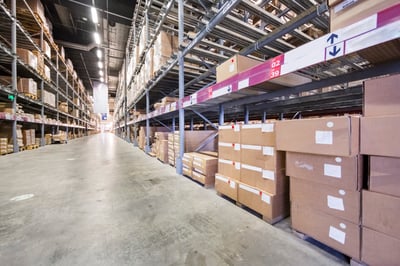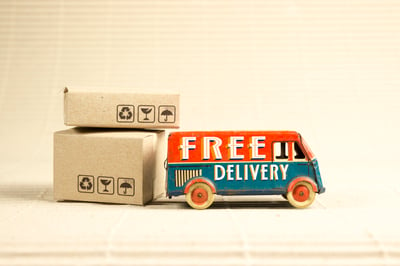March 25, 2025
 by Kimberley Hughes / March 25, 2025
by Kimberley Hughes / March 25, 2025

In the fashion industry, the e-commerce journey from cart to closet is just as important as the products themselves.
In 2025, shoppers expect speed and affordability alongside eco-friendly delivery options. Every fashion and accessories retailer must prepare for the challenge of meeting these expectations while maintaining operational efficiency.
Whether you’re shipping the latest apparel or precious jewelry, the stakes are high: nearly 50% of shoppers abandon their carts when shipping costs or options are unclear. Add to that the complexities of high return rates, peak period surges, and the need to maintain brand consistency at every stage, and it’s clear that effective shipping is a cornerstone of e-commerce success in this industry.
This guide is here to help. From creating a streamlined checkout experience to optimizing fulfillment workflows, we’ll take you through actionable strategies designed to simplify your shipping processes while going beyond customer expectations.
Let’s dive in and explore how you can turn shipping into a profit driver for your fashion brand.
Shipping in the fashion industry is anything but straightforward. With trend cycles moving at lightning speed and customer expectations at an all-time high, brands need to navigate a web of challenges to deliver exceptional experiences.
The risks are especially high in this space, where success depends on balancing operational efficiency with the ability to delight and retain customers with so many options at their fingertips.
Fashion is inherently quick, with demand fluctuating based on seasons, trends, and cultural moments. Brands are often racing against the clock to fulfill orders for limited-edition items or meet the demand of peak shopping periods, like Black Friday and Cyber Monday or holiday seasons. Failing to deliver quickly can mean losing both sales and customer trust.
In a survey conducted by Statista, when asked about the most returned online purchases by category, 24% of U.S. respondents picked “clothing” as their answer.
Additionally, with the rise of “haul culture,” returns are inevitable in fashion. From sizing discrepancies to buyer’s remorse, return rates in the industry are among the highest across e-commerce categories. This creates logistical and financial challenges, especially when handling international returns or managing the environmental impact of reverse logistics.
Shoppers increasingly want the best of both worlds — fast delivery and environmentally friendly practices. Prioritizing both can be a bit of a balancing act, especially when customers expect same-day delivery alongside reduced carbon footprints.
Every touchpoint, from the unboxing experience to order tracking, affects how customers perceive your brand. For fashion and accessories brands, particularly where aesthetics and storytelling make a world of difference, ensuring that shipping and fulfillment reflect your identity is non-negotiable.
A well-thought-out shipping strategy starts at checkout. This is the first touchpoint where customers engage with your fulfillment process, and it’s where their expectations for convenience, reliability, and choice are shaped. Offering flexible options, clear costs, and sustainable alternatives can set the tone for a positive customer experience while reducing cart abandonment.
Let’s take a closer look at how you can optimize your checkout for success.
Fashion shoppers have diverse needs, making it essential to provide tailored shipping choices. Options like standard, same-day, on-demand, or eco-friendly shipping empower customers to choose exactly what works best for their timelines and values.
In an industry that's highly scrutinized for its environmental impact, sustainability in the fashion industry is more than a fad. Carbon-neutral shipping, recyclable or reusable packaging, and partnerships with eco-conscious carriers can all reduce your brand’s environmental footprint. Beyond that, these efforts resonate with consumers who prioritize aligning with responsible brands, reinforcing loyalty and trust.
Unexpected shipping costs are one of the top reasons shoppers abandon their carts. Clear, upfront communication about shipping fees and delivery timeframes is key to building trust and getting customers across the line.
Transparency also reduces friction during the checkout process. For example, flat-rate shipping or free shipping thresholds can make pricing more predictable, further encouraging shoppers to complete their purchases.
Working with multiple carriers allows you to provide a variety of delivery options to suit different budgets, locations, and timelines. This approach ensures flexibility for both you and your customers, whether they’re looking for the fastest delivery available or the most economical choice.
Having a multi-carrier strategy also helps navigate peak demand periods or unexpected disruptions, like delays or surges in shipping costs. The ability to compare and select the best carrier for your specific circumstances ensures a consistent and reliable delivery experience.
For fashion brands with a physical presence, offering in-store pickup or same-day delivery can elevate the customer experience. These options cater to last-minute shoppers and provide a solution that merges the convenience of e-commerce with the immediacy of retail.
Leveraging local delivery networks or services like "Uber On-Demand" for same-day fulfillment can help you stay competitive, especially in urban areas where convenience is key. When combined with clear communication and streamlined operations, these options deliver the speed and flexibility today’s customers expect.
Juggling orders across multiple sales channels can quickly become overwhelming, particularly for fashion brands with diverse customer bases and fast-moving trends.
From online and social media marketplaces to physical retail locations, the complexity of managing inventory, tracking shipments, and ensuring accurate fulfillment grows exponentially as your business and industry scales. That’s where a centralized dashboard becomes your secret weapon.
Selling on platforms like Shopify, Amazon, and eBay — or even running your own direct-to-consumer store — comes with its own set of logistical challenges. Orders from these channels often need to be processed, packed, and shipped in real time, which can result in inefficiencies if data is scattered across multiple disparate systems and platforms.
By centralizing your orders in one platform, you can:
When all your orders are consolidated into a single dashboard, it becomes easier to monitor the status of shipments, track performance metrics, and identify bottlenecks. Having a clear, real-time view of your operations ensures your team can make informed decisions and respond quickly to potential issues, like delays or fulfillment errors.
A centralized system also improves your ability to keep customers informed throughout the shipping process. Automated notifications, accurate delivery estimates, and tracking information can all be seamlessly coordinated, reducing customer inquiries and boosting confidence in your brand.
As your business expands into new markets or adds more sales channels, using a centralized order fulfillment app ensures you are prepared to scale without sacrificing efficiency. Whether you’re entering international markets or testing new fulfillment strategies like same-day delivery, having all your data in one place equips you to adapt and grow with ease.
Efficient e-commerce fulfillment is at the heart of delivering on your shipping promises. In the fashion industry, where speed and accuracy are paramount, well-organized workflows can mean the difference between happy customers and costly delays. By optimizing key processes like tagging, automation, and pick-and-pack, you can build a streamlined operation that scales effortlessly when the time comes.
Shipping automation is a game-changer for fulfillment efficiency. From generating shipping labels to assigning orders to specific couriers, automation reduces manual errors and frees up your team to focus on more strategic tasks.
Some examples of fulfillment tasks you can automate include:
By leveraging automation, you’ll minimize bottlenecks before they happen and increase your team’s capacity.
If you’re using a shipping platform to fulfill your fashion and jewelry orders, then tags are a simple yet powerful way to organize and prioritize your fulfillment process. Whether you need to flag urgent orders, identify specific product categories, or manage wholesale vs. retail orders, tags provide clarity for your team.
For example:
Tags create a visual workflow that keeps your team aligned and ensures no detail is overlooked.
International shipping adds layers of complexity, from navigating customs regulations to calculating global shipping fees. Proactively managing these challenges can save time and prevent delays.
For instance, calculating duties and taxes upfront ensures customers are fully informed of costs before completing their purchases, avoiding unpleasant surprises at the checkout.
Additionally, partnering with carriers experienced in cross-border shipping simplifies this process, ensuring compliance and timely deliveries. Using a shipping platform to automate your customs documentation is yet another way you can streamline your shipping process, as it reduces the chance of errors that may hold up shipments.
The pick-and-pack stage is essential for ensuring orders are fulfilled accurately and on time.
Organizing your warehouse with products located in distinct locations can minimize the time warehouse staff spend moving between shelves, streamlining the picking process.
Barcode scanning, especially with a dedicated mobile app, can improve inventory accuracy, reducing the likelihood of sending incorrect items. During peak seasons, having these processes in place means your team can keep on top of the influx of orders.
A well-optimized pick-and-pack process speeds up fulfillment and reduces errors, leading to happier customers and fewer returns.
Clear and consistent communication during the shipping process is the key to building customer trust. Order notifications and dedicated tracking pages are both great opportunities to enhance the customer experience and reinforce your brand’s identity. By focusing on transparency and personalization, you can turn these touchpoints into a seamless extension of your service.
Key components of engaging in post-purchase communication include:
Order updates are the first step in keeping customers informed and reassured. From order confirmation to delivery updates, timely and detailed notifications reduce the need for “Where’s my order?” inquiries.
Including essential details like the shipping carrier, tracking number, and estimated delivery date ensures customers feel in control of their purchase. Personalizing these notifications, even with a simple brand tone or style, can also help strengthen the connection with your audience.
A branded tracking page goes beyond basic order updates, giving your customers a tailored experience that keeps them engaged. Instead of directing them to a generic carrier site, a branded page can reflect your company’s identity through brand colors, logos, and messaging.
It also provides an opportunity to add value by showcasing complementary products or sharing updates about your brand. These details transform routine order tracking into a memorable interaction that deepens customer loyalty.
Even with a robust tracking system, some customers may have questions or concerns. Ensuring that your customer service contact details are easy to find, both on tracking pages and within your order notifications, can help resolve issues quickly. Providing clear channels for support, like email, SMS, or live chat, shows customers you’re available and committed to addressing their needs.
A well-communicated returns and shipping policy is essential for setting clear expectations. Transparency about eligibility, timeframes, and costs for returns minimizes frustration and encourages repeat purchases. Including these details in tracking emails and on your branded tracking page means shoppers have all the information they need at their fingertips.
Behind every seamless shipping experience is a powerful tech stack working quietly in the background.
For fashion and accessories brands, where agility and precision are essential, the right tools can transform your fulfillment process from just a cost center to a powerful profit driver. Whether it’s leveraging AI for smarter decisions or integrating systems for end-to-end visibility, technology allows you to stay ahead of the competition.
Here are some examples of shipping and fulfillment technology that will take your operations to the next level:
Fulfillment and delivery has become a defining part of the customer experience. For brands in the fashion and accessories industry, getting it right means mastering the balance between speed, sustainability, and reliability. From seamless checkouts to transparent tracking and AI-powered efficiencies, the right strategies will elevate your brand.
By transforming shipping into a strategic advantage, your brand isn’t just keeping up — you’re creating the kind of standout experience that turns first-time buyers into lifelong brand advocates.
Fast shipping is a game-changer for fashion and accessories brands looking to meet customer expectations. Explore how USPS, UPS, and FedEx compare for overnight shipping to choose the best option for your business.
Edited by Shanti S Nair
Kimberley Hughes is a content marketing expert at Starshipit with a knack for turning big ideas into stories that resonate. With a passion for innovative tech, she helps brands find their voice, connect with audiences, and stand out.
Running a business is never easy, and when you're selling wholesale – especially when you're...
 by Jake Rheude
by Jake Rheude
When it comes to the art and magic of branding, few do it better than Disney.
 by Digge Zetterberg Odh
by Digge Zetterberg Odh
Free shipping is a powerful weapon in e-commerce. Helping remove another layer of friction in...
 by Mike Glover
by Mike Glover
Running a business is never easy, and when you're selling wholesale – especially when you're...
 by Jake Rheude
by Jake Rheude
When it comes to the art and magic of branding, few do it better than Disney.
 by Digge Zetterberg Odh
by Digge Zetterberg Odh


